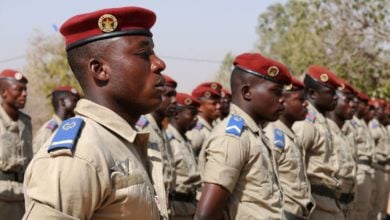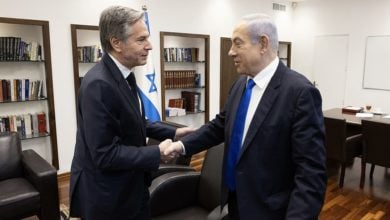Photo: Iraqi Armed Forces and the Popular Mobilization Forces of Iraq celebrate victory against ISIS in Saladin Governorate. Credit: Wikimedia Commons
Since the beginning of Israel’s genocide in Gaza, U.S. forces have carried out multiple strikes in Baghdad and western Iraq, even killing top military commanders within the country’s Popular Mobilization Forces. Iraq’s Hashd al-Shaabi, or “Popular Mobilization Forces,” in English, have made headlines the world over in recent months, especially as U.S. forces in the region have continually escalated attacks on targets associated with the PMF. Western media would have readers uncritically believe the claims that the PMF is an “Iranian proxy,” much the same as the characterization of Lebanon’s Hezbollah or Yemen’s Ansar Allah (also known as the “Houthis”) — but who are the PMF in reality?
An organic Iraqi resistance movement
The PMF has its origins in the resistance to U.S. occupation following the 2003 invasion of Iraq, which toppled the central government and routed the Iraqi Army. It was this movement which was able to deal severe blows to the occupation forces and were essential in the eventual drawdown of U.S. presence in Iraq. The forces that would become the PMF learned many lessons in the fight against the U.S. occupation — most importantly, how to effectively fight an enemy equipped with far superior firepower.
Oppression and occupation will always inspire resistance. During the Iraq War, Western media and U.S. military spokespeople attacked the resistance forces as inspired by “al-Qaeda, loyalty to Saddam Hussein or ‘radical Islam’ to name but a few.” But the reality is that the Iraqi people’s resistance against imperialism was developed over three decades of war, sanctions and occupation at the hands of the U.S. and coalition forces.
Over the last 15 years, the PMF has become an umbrella term for any of the armed groups that formed to battle the so-called Islamic State in Iraq and Syria (ISIS, alternately known as “Daesh” in Arabic). Dozens of factions and tens of divisions, brigades and other formations representing the wide, multi-ethnic and multi-confessional nature of Iraq, make up the PMF.
The Iraqi Armed Forces were not equipped to defend the country against ISIS, and by 2014, the group had captured huge swaths of northern Iraq, including the major northern city of Mosul. During this period, ISIS fighters targeted ethnic and religious minorities — notably the Yazidi people — in the most brutal ways, including through mass murder, sexual slavery and other acts that constitute genocide.
In 2017, independent journalist Rania Khalek embedded with Yazidi units of the PMF in Sinjar Province, in northern Iraq. Khalek described how U.S.-backed Iraqi and Kurdish forces essentially retreated from many of these areas as ISIS advanced, taking their weapons with them and leaving countless civilians to face the ISIS fighters alone. This betrayal inspired hundreds of Yazidi fighters to turn to the PMF to defend their land and loved ones. The Yazidis’ story is one of hundreds that define the history of the PMF over the last 20 years of occupation and resistance.
Sectarianism: Imperialists’ divide-and-conquer strategy
Characterizing the PMF as an “Iranian Proxy” ignores and negates the deep and organic history of resistance on the part of the Iraqi people. To characterize the PMF as a solely Shia organization is factually untrue. For one, Iraq is Shia-majority and there are multiple different ideological tendencies and political formations among Iraqi Shia. Additionally, Sunnis, Christians, as well as ethnic minorities such as Yazidis, Shabakis, Turkmen and others, are also represented in PMF units. What unites these disparate forces is a commitment to resistance against imperialism and sectarianism.
Sectarianism has long been used by imperialists to divide and conquer the Middle East. From British and French imperialists drawing up the borders of the modern Middle East as part of the Sykes-Picot agreement to Lebanon’s imposed confessional parliamentary system to Bush-era schemes to partition Iraq into three countries along the lines of Sunni, Shia and Kurdish regions, ethnic and religious infighting has always been a key tool of imperialist domination. And despite its support for Saddam Hussein in the 1980s, in the immediate lead-up to the 2003 invasion of Iraq the U.S. government cynically invoked the language of human rights to portray his government as one of a Sunni Arab minority “silencing” and “repressing” other religious and ethnic groups and drum up support for war. Then, after toppling Saddam’s Ba’athist government, the narrative eventually shifted to one of “Iran-backed militias” or even “proxies” “capturing” Iraq. It is clear that the U.S. government has never cared about about religious or ethnic minorities in the region, but only uses them as pawns in its imperialist chessboard.
And while the implication here is that Iran is controlling Shia forces across the region, and that this is an existential threat to Sunnis and other sects in the region, the actual track record of Iran in this regard could not be more opposite.
Iran’s actual role
On Jan. 2, 2020, the US military assassinated Iranian General Qasem Soleimani and Abu Mahdi al-Muhandis, a leader in one of the most important PMF-affiliated groups, the Kata’ib Hezbollah with an airstrike in Baghdad. Soleimani, a general in the Iranian Revolutionary Guard Corps elite Quds Forces, spent the last two decades organizing what is now known as the “Resistance Axis,” a network of autonomous, locally organized military actors united around resistance to U.S. imperialism and Zionism in the region.
Iran provides varying levels of support to groups within the Resistance Axis — advisors and trainers, weapons and ammo, and other such support — but does not maintain any operational command of these forces. From the Palestinian Resistance and Hezbollah to Ansar Allah and the PMF, Iran has consistently backed the creation of indigenous resistance capacity and coordination across the region.
This is most clearly demonstrated in the ingenuity of the Palestinian resistance forces which have developed the capacity to produce their own missiles and weapons under the strictest conditions of siege in Gaza. Iran is not looking to create dependents, but understands its interests are aligned with the interests of organic anti-imperialist and anti-Zionist movements across the region. To U.S. imperialists for whom everything is a transaction, it is near impossible to imagine that resistance forces in Lebanon, Yemen and Iraq would put themselves at risk defending the Palestinian people without getting orders and funding from Tehran.
U.S. empire is the real terrorist
Far from these forces representing a network of “terrorist organizations,” it is the U.S. empire that is the real terrorist state in the region. Between funding and facilitating Israeli settler-colonialism and genocide in Palestine, the brutal sanctions regime levied against countless countries, covert funding for extremely reactionary elements from the Afghan Mujahideen to Lebanese Christian fascists, and the campaigns of mass murder against the people of Afghanistan, Iraq, Yemen and Libya, the U.S. government has stoked sectarianism, enforced neocolonial underdevelopment, and made sure to smear and attack any resistance to these imperialist designs as “terrorists.”





